Ancre Heights
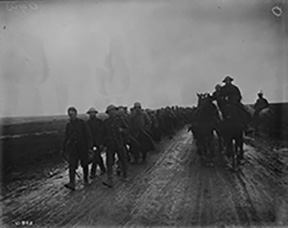
German Prisoners captured by Canadians in the storming of Regina Trench. October, 1916.
Credit: Canada. Department of National Defence/Library and Archives Canada; (MIKAN no. 3403055)
First World War
Date
1 October – 11 November 1916
Geographical parameters
Road Pys – le Sars – Martinpuich – Contalmaison – la Boiselle – Aveluy – Martinsart – Mesnil – Hamel
Context
A battle honour incorporating the tactical incident “Capture of Schwaben and Stuff Redoubts and Regina Trench”, formally entitled the “Battle of The Ancre Heights”, and itself being part of the “Operations on the Somme (1 July – 18 November 1916)”.Footnote 1
Description
The Honour “Ancre Heights” was given for British offensives in October and November 1916 meant to continue pressing the Germans towards Bapaume in the east and towards the Ancre River in the north. The objective of the battles for Ancre Heights was to capture the dominating ground that protected the German rear areas of the Ancre valley. As part of these offensives it was the task of the Canadian Corps (Lieutenant-General Sir J.H.G. Byng) to take Regina Trench, which was then to serve as a jumping off point for attacks further north. Situated over the crest on the highest point on the ridge, Regina Trench was difficult for artillery to target and an excellent position for the Germans to defend. On the 1st of October, the first attack by the Canadian Corps on Regina Trench was made primarily by the 2nd Canadian Division (Major-General R.E.W. Turner, VC) with the 8th Brigade (Brigadier-General J.H. Elmsley) of the 3rd Division attacking on its left. Only small parties of Canadians made it to Regina Trench. Regardless of their valiant efforts, most of the attackers were stopped by German machine guns and uncut wire. Ordered to continue the attack, the Canadian Corps had to wait a week due to bad weather. The second attempt to take Regina Trench was divided equally between 1st and 3rd Divisions, (Major-General A.W. Currie and Major-General L.J. Lipsett) each with two Brigades attacking. Again some groups of Canadians made it to Regina Trench but the Germans successfully repulsed the attacks, forcing the Canadians back to their start points. The same problems persisted as with the first attack. The artillery had not cut the wire nor destroyed the German positions in Regina Trench. This was the Canadian Corps final battle on the Somme, but the 4th Canadian Division (Major-General Sir D. Watson) newly arrived in France was assigned to the 2nd British Corps, taking its position on that Corps' right flank. On 21 October the Battle of the Ancre Heights was resumed. This time the heavy artillery bombardment succeeded in destroying the German wire and portions of Regina Trench were taken by the assaulting forces. For the next two weeks the steadily deteriorating weather precluded major operations. Then, at midnight 10/11 November 1916, the final assault went in, covered by what was described as a ‘perfect' artillery barrage. The remaining enemy positions were quickly secured and the Ancre Heights battle came to a successful conclusion.
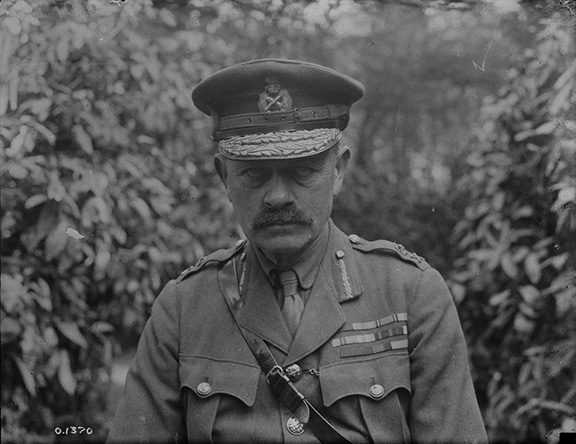
Sir Julian Byng, General officer commanding the Canadian Corps, June 1916-June 1917. Location unknown. May, 1917.
Credit: Canada. Department of National Defence/Library and Archives Canada; (MIKAN no. 3213526)
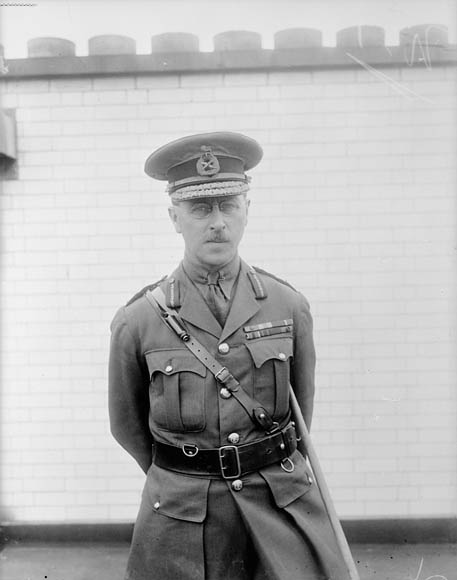
Lieutenant-General R.E.W. Turner, V.C. Location unknown. 1914-1919
Credit: Canada. Department of National Defence/Library and Archives Canada /PA-007941; (MIKAN no. 3221894)
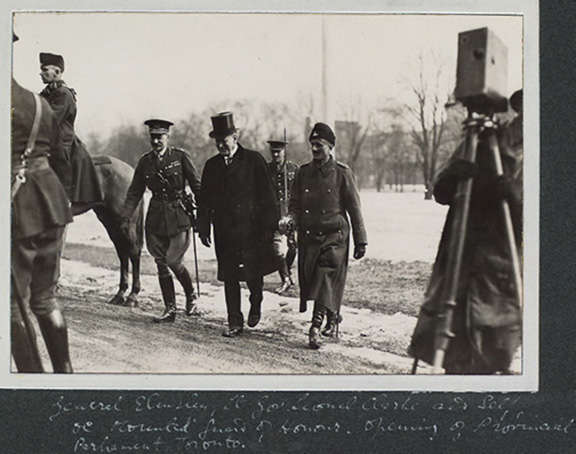
From left to right, General James Elmsley, Lieutenant-Governor Lionel Clarke and Reginald S.Timmis attending the opening of Provincial Parliament, Toronto, Ont. 1920. -Insc. on mount below photo: General Elmsley, Lt. Gov. Lionel Clarke and Self, oc Mounted Guard of Honour. Opening of Provincial Parliament, Toronto. 1920
Credit: Timmis, Reginald Symonds, 1884-1968; Baldwin Collection; Toronto Reference Library 995-1-10-13a
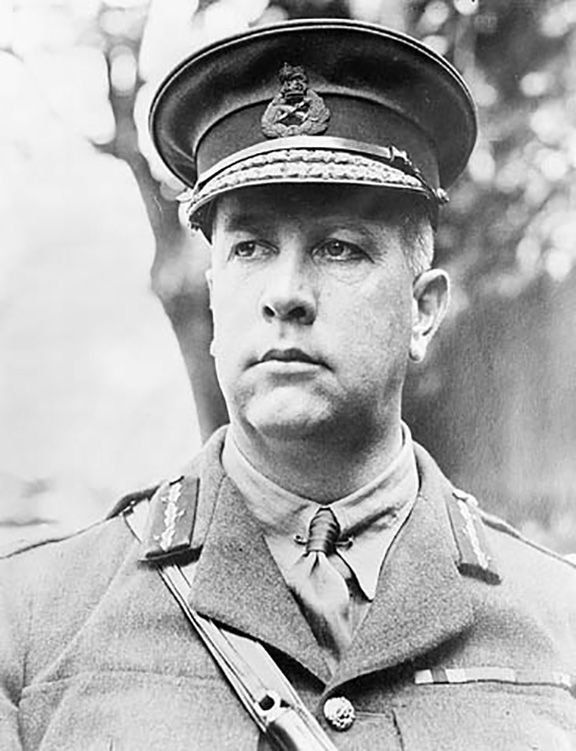
Lieutenant General Currie, Commander of the Canadian Corps in France, and A.D.C. Location unknown. June, 1917.
Credit: Canada. Department of National Defence/Library and Archives Canada/PA-001370; (MIKAN no. 3191901)
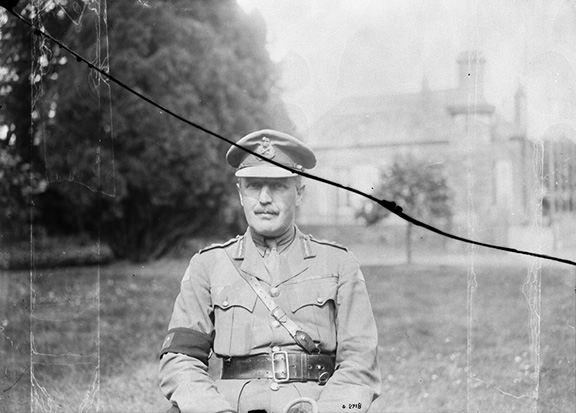
Major-General L.J. Lipsett, commander of the 3rd Canadian Division. Camblain l'Abbé. May, 1918.
Credit: Canada. Department of National Defence/Library and Archives Canada; (MIKAN no. 3218379)
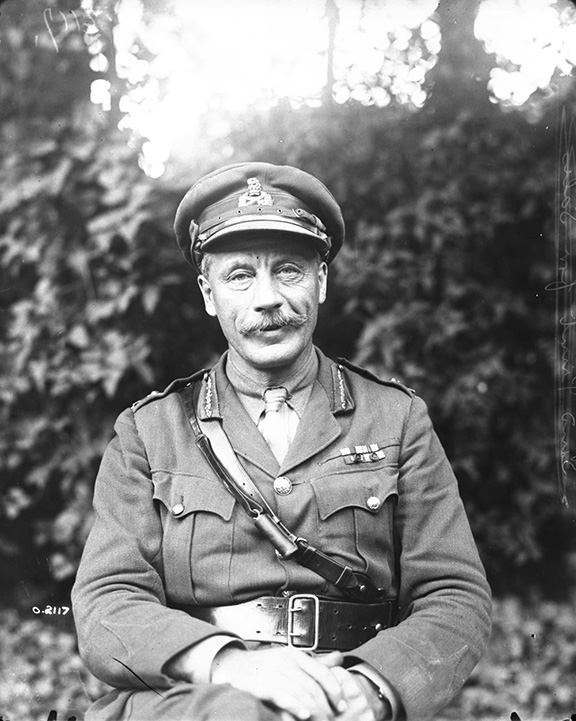
Major-General Watson, the Officer Commanding the 4th Canadian Division. Location unknown. October, 1917.
Credit: Canada. Department of National Defence/Library and Archives Canada; (MIKAN no. 3222150)
Awarded to:
Currently serving units
- 1st Hussars
Award to the 1st Hussars (GO 71/30) - 48th Highlanders of Canada
Awards to the 15th Canadian Infantry Battalion, CEF (GO 110/29) and The 48th Regiment (Highlanders) (GO 110/29) - 56th Field Artillery Regiment, RCA
Awards to the 4th Canadian Infantry Battalion, CEF (GO 110/29) and The Dufferin Rifles of Canada (GO 110/29) - The Argyll and Sutherland Highlanders of Canada (Princess Louise's)
Awards to the 19th Canadian Infantry Battalion, CEF (GO 110/29) and The Argyll and Sutherland Highlanders of Canada (Princess Louise's) (GO 110/29) - The Black Watch (Royal Highland Regiment) of Canada
Awards to the 13th Canadian Infantry Battalion, CEF (GO 110/29), the 42nd Canadian Infantry Battalion, CEF (GO 110/29), the 73rd Canadian Infantry Battalion, CEF (GO 110/29), and The Royal Highlanders of Canada (GO 110/29) - The British Columbia Dragoons
Awards to the 2nd Canadian Mounted Rifles Battalion, CEF (GO 110/29) and The British Columbia Dragoons (GO 110/29) - The British Columbia Regiment (Duke of Connaught's Own)
Awards to the 7th Canadian Infantry Battalion, CEF (GO 71/30), the 29th Canadian Infantry Battalion, CEF (GO 123/29), the 102nd Canadian Infantry Battalion, CEF (GO 110/29), the 1st British Columbia Regiment (Duke of Connaught's Own) (GO 110/29), The North British Columbia Regiment (GO 123/29) and The Vancouver Regiment (GO 71/30) - The Calgary Highlanders
Awards to the 10th Canadian Infantry Battalion, CEF (GO 123/29) and The Calgary Highlanders (GO 110/29) - The Cameron Highlanders of Ottawa
Awards to the 38th Canadian Infantry Battalion, CEF (GO 123/29) and The Ottawa Highlanders (GO 110/29) - The Canadian Grenadier Guards
Awards to the 87th Canadian Infantry Battalion, CEF (GO 110/29) and The Canadian Grenadier Guards (GO 110/29) - The Canadian Scottish Regiment (Princess Mary's)
Awards to the 16th Canadian Infantry Battalion, CEF (GO 110/29), the 3rd Pioneer Battalion (48th Canadians), CEF (GO 110/29), the 67th Canadian (Pioneer) Battalion, CEF (GO 123/29), and The Canadian Scottish Regiment (GO 110/29) - The Essex and Kent Scottish
Awards to the 18th Canadian Infantry Battalion, CEF (GO 110/29) and The Essex Scottish (GO 110/29) - Governor General's Foot Guards
Awards to the 2nd Canadian Infantry Battalion, CEF (GO 123/29) and The Governor General's Foot Guards (GO 32/32) - The Governor General's Horse Guards
Awards to the 4th Canadian Mounted Rifles Battalion, CEF (GO 110/29), The Governor General's Body Guard (GO 112/35), and The Mississauga Horse (GO 110/29) - The King's Own Calgary Regiment (RCAC)
Awards to the 50th Canadian Infantry Battalion, CEF (GO 110/29) and The Calgary Regiment (GO 110/29) - The Lake Superior Scottish Regiment
Awards to the 52nd Canadian Infantry Battalion, CEF (GO 123/29) and The Lake Superior Regiment (GO 110/29) - The Loyal Edmonton Regiment (4th Battalion, Princess Patricia's Canadian Light Infantry)
Awards to the 49th Canadian Infantry Battalion, CEF (GO 110/29) and The Edmonton Regiment (GO 110/29) - The North Saskatchewan Regiment
Awards to the 1st Canadian Mounted Rifles Battalion, CEF (GO 110/29), the 5th Canadian Infantry Battalion, CEF (GO 110/29), the 16th Canadian Light Horse (GO 110/29), The Saskatchewan Mounted Rifles (GO 110/29) and The Saskatoon Light Infantry (GO 110/29) - The Nova Scotia Highlanders
Awards to the 25th Canadian Infantry Battalion, CEF (GO 123/29) and The Colchester and Hants Regiment (GO 110/29) - The Princess of Wales' Own Regiment
Awards to the 21st Canadian Infantry Battalion, CEF (GO 123/29) and The Princess of Wales' Own Regiment (GO 110/29) - Princess Patricia's Canadian Light Infantry
Award to Princess Patricia's Canadian Light Infantry (GO 123/29) - The Queen's Own Cameron Highlanders of Canada
Awards to the 43rd Canadian Infantry Battalion, CEF (GO 110/29) and The Queen's Own Cameron Highlanders of Canada (GO 110/29) - The Queen's Own Rifles of Canada
Awards to the 3rd Canadian Infantry Battalion, CEF (GO 123/29) and The Queen's Own Rifles of Canada (GO 110/29) - The Queen's York Rangers (1st American Regiment) (RCAC)
Awards to the 20th Canadian Infantry Battalion, CEF (GO 110/29) and The Queen's Rangers, 1st American Regiment (GO 110/29) - Royal 22e Régiment
Award to the Royal 22e Régiment (GO 110/29) - The Royal Canadian Regiment
Awards to the 1st Canadian Infantry Battalion, CEF (GO 110/29), The Royal Canadian Regiment (GO 110/29) and The Canadian Fusiliers (City of London Regiment) (GO 110/29) - The Royal Hamilton Light Infantry (Wentworth Regiment)
Awards to the 4th Canadian Infantry Battalion, CEF (GO 110/29) and The Royal Hamilton Light Infantry (GO 110/29) - The Royal Montreal Regiment
Awards to the 14th Canadian Infantry Battalion, CEF (GO 110/29) and The Royal Montreal Regiment (GO 110/29) - The Royal New Brunswick Regiment
Awards to the 26th Canadian Infantry Battalion, CEF (GO 110/29), The Carleton Light Infantry (GO 110/29) and The Saint John Fusiliers (GO 110/29) - The Royal Regiment of Canada
Awards to the 3rd Canadian Infantry Battalion, CEF (GO 123/29), the 58th Canadian Infantry Battalion, CEF (GO 110/29), The Royal Grenadiers (GO 110/29), and The Toronto Regiment (GO 110/29) - The Royal Regina Rifles
Awards to the 28th Canadian Infantry Battalion, CEF (GO 110/29) and The Regina Rifle Regiment (GO 110/29) - The Royal Westminster Regiment
Awards to the 47th Canadian Infantry Battalion, CEF (GO 110/29) and The Westminster Regiment (GO 110/29) - The Royal Winnipeg Rifles
Awards to the 8th Canadian Infantry Battalion, CEF (GO 110/29), the 10th Canadian Infantry Battalion, CEF (GO 123/29), the 27th Canadian Infantry Battalion, CEF (GO 123/29), the 44th Canadian Infantry Battalion, CEF (GO 110/29), The Winnipeg Rifles (GO 110/29) and The Winnipeg Light Infantry (GO 110/29) - The Saskatchewan Dragoons
Awards to the 46th Canadian Infantry Battalion, CEF (GO 110/29) and The King's Own Rifles of Canada (GO 110/29) - The Seaforth Highlanders of Canada
Awards to the 72nd Canadian Infantry Battalion, CEF (GO 5/31) and The Seaforth Highlanders of Canada (GO 5/31) - The Sherbrooke Hussars
Awards to the 5th Canadian Mounted Rifles Battalion, CEF (GO 110/29) and the 7th/11th Hussars (GO 10/39) - The South Alberta Light Horse
Awards to the 31st Canadian Infantry Battalion, CEF (GO 110/29), The South Alberta Regiment (GO 110/29) and the 19th Alberta Dragoons (GO 71/30) - The Toronto Scottish Regiment (Queen Elizabeth The Queen Mother's Own)
Awards to the 75th Canadian Infantry Battalion, CEF (GO 110/29) and The Toronto Scottish Regiment (GO 110/29)
Units on the Supplementary Order of Battle
- 24th Field Artillery Regiment, RCA
Awards to the 54th Canadian Infantry Battalion, CEF (GO 110/29) and The Kootenay Regiment (GO 110/29) - 27th Field Artillery Regiment, RCA
Award to The Eastern Townships Mounted Rifles (GO 110/29) - 50th Field Artillery Regiment (The Prince of Wales' Rangers), RCA
Awards to the 2nd Canadian Infantry Battalion, CEF (GO 123/29) and The Peterborough Rangers (GO 110/29) - 118th Medium Battery, RCA
Awards to the 1st Canadian Mounted Rifles Battalion, CEF (GO 110/29) and The Manitoba Mounted Rifles (GO 5/31) - Victoria Rifles of Canada
Awards to the 24th Canadian Infantry Battalion, CEF (GO 110/29), the 60th Canadian Infantry Battalion, CEF (GO 110/29), and The Victoria Rifles of Canada (GO 110/29) - The Winnipeg Grenadiers
Awards to the 78th Canadian Infantry Battalion, CEF (GO 110/29) and The Winnipeg Grenadiers (GO 110/29)
Disbanded Units
- 1st Canadian Pioneer Battalion, CEF
Award to the 1st Canadian Pioneer Battalion, CEF (GO 88/31) - 2nd Canadian Pioneer Battalion, CEF
Award to the 2nd Canadian Pioneer Battalion, CEF (GO 123/29) - The Manitoba Regiment
Award to The Manitoba Regiment (GO 123/29) - The North Alberta Regiment
Awards to the 31st Canadian Infantry Battalion, CEF (GO 110/29) and The North Alberta Regiment (GO 110/29)
Page details
- Date modified: